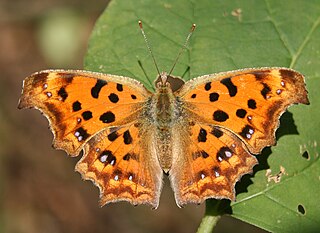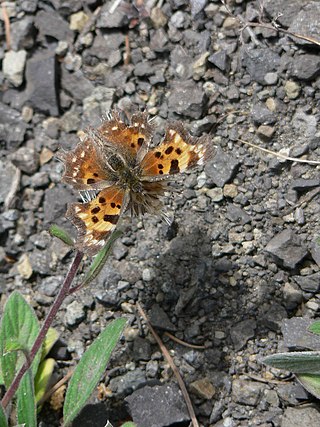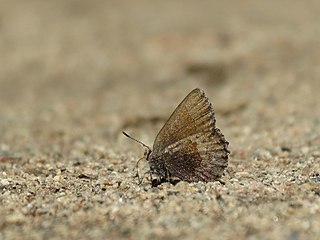
Rhododendron is a very large genus of about 1,024 species of woody plants in the heath family (Ericaceae). They can be either evergreen or deciduous. Most species are native to eastern Asia and the Himalayan region, but smaller numbers occur elsewhere in Asia, and in North America, Europe and Australia.

Polygonia c-album, the comma, is a food generalist (polyphagous) butterfly species belonging to the family Nymphalidae. The angular notches on the edges of the forewings are characteristic of the genus Polygonia, which is why species in the genus are commonly referred to as anglewing butterflies. Comma butterflies can be identified by their prominent orange and dark brown/black dorsal wings.

Polygonia interrogationis, commonly called the question mark butterfly, is a North American nymphalid butterfly. It lives in wooded areas, city parks, generally in areas with a combination of trees and open space. The color and textured appearance of the underside of its wings combine to provide camouflage that resembles a dead leaf. The adult butterfly has a wingspan of 4.5–7.6 cm (1.8–3.0 in). Its flight period is from May to September. "The silver mark on the underside of the hindwing is broken into two parts, a curved line and a dot, creating a ?-shaped mark that gives the species its common name."

Polygonia is a genus of butterflies with a conspicuous white mark on the underside of each hindwing, hence the common name comma. They also have conspicuous angular notches on the outer edges of their forewings, hence the other common name anglewing butterflies. The related genus Nymphalis also includes some anglewing species; Polygonia is sometimes classified as a subgenus of Nymphalis.

Rhododendron calendulaceum, the flame azalea, is a species of Rhododendron. It is a deciduous shrub that grows up to 120–450 cm tall. This species of Rhododendron is native to the Appalachian Mountains in the eastern United States, ranging from southern Pennsylvania and Ohio to northern Georgia. It may be extirpated from Pennsylvania and Alabama. It occurs naturally in mixed deciduous forests and is typically found in woodland slopes and mountain balds in the Appalachians, where it prefers dry and rocky mountain woods. The inflorescences of Rhododendron calendulaceum are visited by many animals such as bees, butterflies, hummingbirds and small mammals. It is a popular cultivated plant due to its bright yellow, orange or red flowers.

Polygonia c-aureum, the Asian comma, is a middle-size butterfly found in Japan, Korean Peninsula, China, Taiwan, and Indochina.

Polygonia comma, the eastern comma, is a North American butterfly in the family Nymphalidae, subfamily Nymphalinae.

Polygonia oreas, the oreas comma, is a butterfly of the family Nymphalidae. It is found in North America in the mountains from southern British Columbia and southwestern Alberta to northern California.

Nymphalis vaualbum or N. l-album, the Compton tortoiseshell, or false comma, is a species of butterfly in the family Nymphalidae.

Polygonia faunus, the green comma, Faunus comma, or Faunus anglewing is a butterfly of the family Nymphalidae.

Polygonia progne, the gray comma or grey comma, is a species of Polygonia that occurs in North America.

Polygonia satyrus, the satyr comma, is a North American butterfly of the nymphalid family. It is primarily found in western Canada, where it is locally common. It bears a resemblance to Polygonia comma, the eastern comma, with which it is frequently confused. Its caterpillars feed on Urtica dioica - Stinging Nettle.
P. gracilis may refer to:

Callophrys polios, the hoary elfin, is a butterfly of the family Lycaenidae. It has a very local distribution in the United States from Maine south to New Jersey and in the Appalachian Mountains to Virginia, west across the Great Lakes states and the southern prairie provinces and north to Alaska. Along the Pacific Coast it is found to northern California and in the Rocky Mountains south to northern New Mexico. It is listed as a species of special concern and believed extirpated in the US state of Connecticut.














